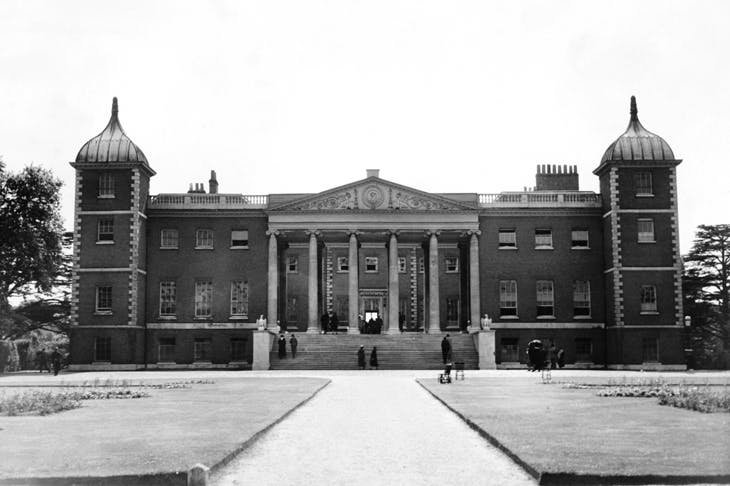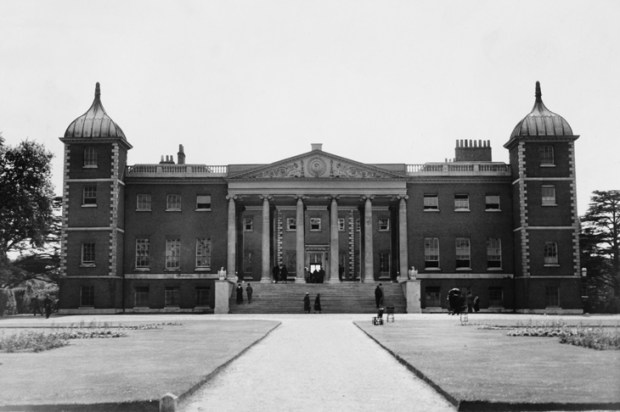Osterley Park on the western fringes of London is a rare survival. A Robert Adam house, with splendid Adam interiors, it’s still surrounded by its Elizabethan stables, an 18th-century landscape and classical follies — in the middle of urban Hounslow. Over the past decade, this Georgian gem has been increasingly despoiled and dumbed down by the National Trust.
The Trust is spending £356,000 to turn Osterley Park into a child-friendly leisure centre. As one of the huge posters strapped to the park fence says, the money will pay for ‘A new skills area for young families providing kids with a safe place to learn to cycle and gain confidence’. Why splurge this vast amount of money on something you can already easily do on the paths at Osterley, i.e. bicycle? And why use pointless language like ‘skills area’ and ‘safe place’, instead of just calling it ‘a place where you can learn to ride a bike’?
It’s just a small part of the disastrous dumbing-down of the National Trust — all in the name of the Trust’s great gods: accessibility, interpretation and storytelling. Everywhere you go now at Trust properties, you’re never allowed a free thought without being bombarded by idiotic, history-free messages.
At Prior Park, Bath, one of the greatest mid-18th-century landscapes in the country, the grotto has been ruined by an enormous video screen, with a cartoon showing a Disneyfied vision of Prior Park. No facts are allowed to intervene in National Trust Kiddy World. Instead, the noticeboard outside the grotto asks you to ‘Think about how each area of the garden makes you feel…’. By the elegant, urn-topped piers at the entrance to Prior Park, a massive purple-and-white poster asks you to ‘Join the Cadbury Egg Hunt — Enjoy Easter Fun at the National Trust.’
Try walking round the garden at Kingston Lacy in Dorset and you can’t move for blackboard signs propped against the trees, scrawled on in chalk, saying, ‘Snowdrop-lovers are also known as galanthophiles.’
Open a kitchen cupboard in Standen, the arts-and-crafts house in West Sussex, and you’re presented with a rolling pin, a mixing bowl and a copy of the Daily Mirror from 1942, with a photo of General Eisenhower on the cover. Why? Who keeps their newspaper in a kitchen cupboard? Move into the dining room and, on a bright spring lunchtime, the curtains are closed, while the table’s set for dinner, with electric candles and tureens of plastic carrots and potatoes.
At Wimpole Hall, Cambridgeshire, at lunchtime, the table in the 18th-century parlour is set for tea, with a plastic fruitcake and a copy of the Daily Telegraph from 3 June 1953, the day after the Queen’s Coronation. In a nearby chair, there’s a copy of Country Life from February 1976, showing a snowy lakeside scene. So where are we supposed to be? Eighteenth-century Wimpole Hall, summer 1953 or winter 1976? We’re never told.
These weird, empty stage sets are upper-class murder scenes — as if the Earl of Hardwicke has been whipped away from the tea table just as he’s about to have a slice of cake, and strangled somewhere in the servants’ quarters — or ‘The Servant’s Rooms’, as they are called in the illiterate signs at Osterley.
The desire for fact-free interpretation is so great that the National Trust has even taken to writing rubbish on doors and blinds. At Standen, the butler’s pantry door is painted with the banal words, ‘After breakfast at eight I would go into the pantry and make sure that the silver was polished according to what they wanted that day.’
When National Trust signs aren’t illiterate, they are patronising, as at Osterley: ‘It was the scullery maid’s job to empty and clean the chamber pots every morning. A very smelly job.’ A tree stump at Hughenden has a sign next to it saying, ‘Please do not climb on me.’ At Cliveden in Buckinghamshire, work on the South Terrace is fitted around the bats’ hibernation cycle: ‘Can you believe every-thing has to be scheduled around this sleepy little chap and his friends?’ reads the notice. If any facts do sneak into the signs, they have to be dumbed down, too. So the Kingston Lacy estate is described as once covering ‘over 10,000 hectares (over 14,000 football pitches!)’
The overall effect is extremely depressing. You go away from National Trust houses weighed down with namby-pamby, childish, hectoring commands, constantly ordered to think in a particular way. Gone is the magical, mysterious, sublime aesthetic effect that unadulterated great houses and landscapes gently lay down on your soul. The moment beauty is explained, it loses its lustre.
The National Trust need to attract visitors but they don’t have to destroy themselves in the process. Blenheim and Chatsworth are vast money-making operations, but they haven’t turned themselves into kiddy parks to get punters through the door. They know that the beauty and history of their houses and parks are their own magnetic attraction.
In all the houses I’ve been to, I never saw a single child look at the dumbed-down notices, either. The Trust is destroying these places to no real purpose.
But that doesn’t matter. Interpretation and storytelling have become ends in themselves under the current director-general, Helen Ghosh, and her predecessor, Fiona Reynolds. Helen Ghosh was the one who said National Trust houses had ‘so much stuff’ in them that, in 2015, furniture was temporarily removed from Ickworth’s library to make way for beanbags. She is also the one who has turned the Trust into an eco-charity, declaring, ‘The effect of extreme weather is the single largest threat to our conservation work.’
In the face of the green tide, curatorial scholarship has been discarded. I have been at a seminar where a senior National Trust employee declared that the reaction of someone who knows nothing about Stowe and its gardens is as valid as a leading architectural historian’s reaction. I have heard the head of one of London’s great museums say they were horrified that the Trust’s Peckover House in Wisbech had no Polish agricultural workers visiting from nearby towns.
Some brave curators take a stand against the idiocy. One in the West Country, talking off the record to avoid reprisals, objected when asked to take a death mask off a wall because it was too ‘gloomy’ for the children. As the curator wisely told them, ‘Children love death and gloom.’ What’s much more gloomy is when the greatest conservation charity in the world turns into a politicised leisure centre.
Got something to add? Join the discussion and comment below.
Get 10 issues for just $10
Subscribe to The Spectator Australia today for the next 10 magazine issues, plus full online access, for just $10.














Comments
Don't miss out
Join the conversation with other Spectator Australia readers. Subscribe to leave a comment.
SUBSCRIBEAlready a subscriber? Log in